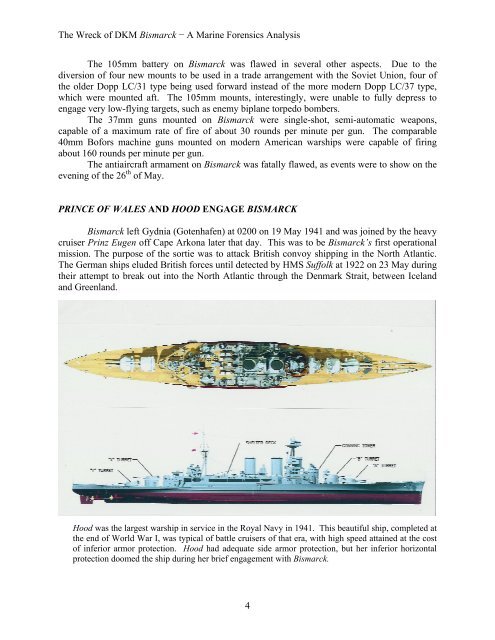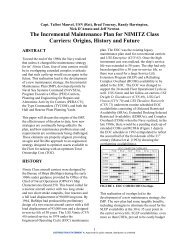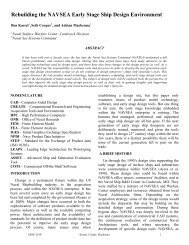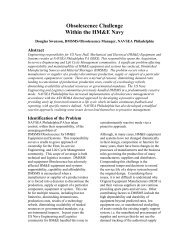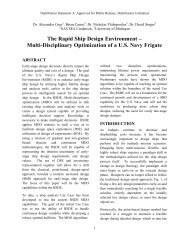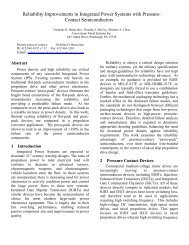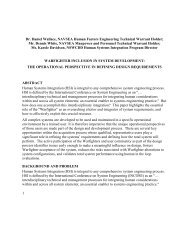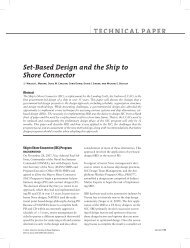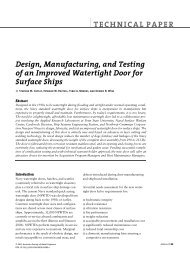The Wreck of DKM Bismarck − A Marine Forensics Analysis 1 The ...
The Wreck of DKM Bismarck − A Marine Forensics Analysis 1 The ...
The Wreck of DKM Bismarck − A Marine Forensics Analysis 1 The ...
You also want an ePaper? Increase the reach of your titles
YUMPU automatically turns print PDFs into web optimized ePapers that Google loves.
<strong>The</strong> <strong>Wreck</strong> <strong>of</strong> <strong>DKM</strong> <strong>Bismarck</strong> <strong>−</strong> A <strong>Marine</strong> <strong>Forensics</strong> <strong>Analysis</strong><br />
<strong>The</strong> 105mm battery on <strong>Bismarck</strong> was flawed in several other aspects. Due to the<br />
diversion <strong>of</strong> four new mounts to be used in a trade arrangement with the Soviet Union, four <strong>of</strong><br />
the older Dopp LC/31 type being used forward instead <strong>of</strong> the more modern Dopp LC/37 type,<br />
which were mounted aft. <strong>The</strong> 105mm mounts, interestingly, were unable to fully depress to<br />
engage very low-flying targets, such as enemy biplane torpedo bombers.<br />
<strong>The</strong> 37mm guns mounted on <strong>Bismarck</strong> were single-shot, semi-automatic weapons,<br />
capable <strong>of</strong> a maximum rate <strong>of</strong> fire <strong>of</strong> about 30 rounds per minute per gun. <strong>The</strong> comparable<br />
40mm B<strong>of</strong>ors machine guns mounted on modern American warships were capable <strong>of</strong> firing<br />
about 160 rounds per minute per gun.<br />
<strong>The</strong> antiaircraft armament on <strong>Bismarck</strong> was fatally flawed, as events were to show on the<br />
evening <strong>of</strong> the 26 th <strong>of</strong> May.<br />
PRINCE OF WALES AND HOOD ENGAGE BISMARCK<br />
<strong>Bismarck</strong> left Gydnia (Gotenhafen) at 0200 on 19 May 1941 and was joined by the heavy<br />
cruiser Prinz Eugen <strong>of</strong>f Cape Arkona later that day. This was to be <strong>Bismarck</strong>’s first operational<br />
mission. <strong>The</strong> purpose <strong>of</strong> the sortie was to attack British convoy shipping in the North Atlantic.<br />
<strong>The</strong> German ships eluded British forces until detected by HMS Suffolk at 1922 on 23 May during<br />
their attempt to break out into the North Atlantic through the Denmark Strait, between Iceland<br />
and Greenland.<br />
Hood was the largest warship in service in the Royal Navy in 1941. This beautiful ship, completed at<br />
the end <strong>of</strong> World War I, was typical <strong>of</strong> battle cruisers <strong>of</strong> that era, with high speed attained at the cost<br />
<strong>of</strong> inferior armor protection. Hood had adequate side armor protection, but her inferior horizontal<br />
protection doomed the ship during her brief engagement with <strong>Bismarck</strong>.<br />
4


